English
Guildhall Connect No.6 - School project
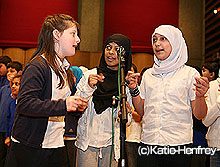
School project(2008)
In the precious 5 articles about Guildhall Connect, we have seen 'Connect' projects run by the Guildhall School of Music and Drama, which are about making music with young people who are interested in music. This time, I will report on one of their school projects, 'Dynamic Changes', through which musicians from the Guildhall School visit local schools and make music together.
Title: Guildhall Connect 'Dynamic Changes'
Venue: 8 primary schools in Tower Hamlets in London / Hackney Round Chapel
Target: 10 classes of primary schools, 20-30 students each, aged between 6&7
Sessions: 7 sessions of 2-to-3-hour-workshops on weekdays in January to March, 2010
Concert: Thursday 18th March 2010, 9:30-12:00
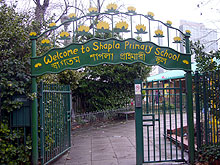
To one of the local schools
The Guildhall School has a long-term relationship with its local schools in east London through music projects (See the interview). One of them, called 'Dynamic Changes', was a music making and performance project with primary schools in Tower Hamlets in east London, which was the second series since 2008.
Its leaders were students and graduates from the Leadership course at the Guildhall School. This was one of the compulsory projects for the students in the second year of the master's course. 10 classes from 8 schools in Tower Hamlets participated, and a total of about 15 musicians formed groups of 2 to 3, and visited 1 or 2 schools each.
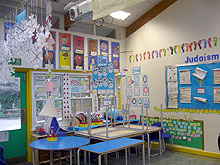
Workshop in the usual classroom
It was a joint project between the Guildhall School and Tower Hamlets Arts and Music Education Service : the Music Service selected particular schools who were not currently involved in whole-class instrumental tuition in their schools, and engaged in fundraising; while the Guildhall School was in charge of the musicians and music content. Tower Hamlets Arts and Music Education Service is part of the Council, providing local children and young people aged 14-18 with music education activities and musical support, and funded by the DCSF's (the Department for Children, Schools and Families (now the the Department for Education)) Music Standard Fund. With the aim of giving every young person in the borough access to musical experiences, THAMES offers schools instrumental, vocal and ensemble tuition, performance opportunities, training, a Saturday Music Centre for young people, and a high number of music and arts projects run by local and national arts organization, including the Guildhall School, London Symphony Orchestra and Wigmore Hall.
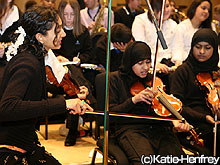
School project(2008)
On the other hand, those who were leading the musicians and devising the content were Detta and Natasha, familiar members of Guildhall Connect (See No.4). They said, 'When we were asked to curate this Dynamic Changes project, it was hard to envisage the kind of performance that would be the result of so many people working together. We did feel strongly that if we could get all ten schools exploring the same themes, then it would have the potential to be a hugely exciting project and performance'.
The musicians brought 'the same themes' to each school seven times for over two months, doing 2-3 hours of workshops. 'The same theme' this time was the 'five senses'. Giving one of five senses of 'See' 'Hear' 'Smell' 'Taste' 'Touch' to each of 10 classes, they made their original music from scratch, based on the sense that they had been allotted.

Leaders discussing ideas
Shapla School was in charge of 'Taste'. Mike, a graduate of two years ago, and Fernando and Eiko, both in their second year of the master's course, went to the classroom as leaders. Firstly, the whole class put forward their ideas about 'Taste' to each other; 'What kind of taste do we have?', 'What is your favourite taste?' Then they formed the idea that there are different tastes according to the season and time of day, and started to compose a song entitled the 'Taste of My Life'. About 20 children formed some smaller groups and devised lyrics and melodies for them. Finally, the song began when we woke up feeling hungry and had a cup of tea, then explored the taste of morning, evening and even in our dreams, then included their favourite taste, such as chocolate, pizza, fruit juice and chicken.
After four sessions, the song was nearly finished. When Mike asked the children, 'Do you remember the song? Who wants to tell me?', then the children raised their hands and answered line by line: 'Hungry and starving,' 'OK, what's next?', and so on. Even though no-one could remember the whole lyrics, when gathering the whole class, they could recall the whole song perfectly. They decided to choreograph everything into a concert, 'Hot soft samosa', with their hands forming the shape of a triangle like a samosa; 'Spicy chicken wing' with the flapping gesture of a chicken, and so on. They were happy to put forward ideas. The choreography helped the children not only to enjoy the performance, but also to remember the lyrics. Also, the leaders added clapping to the rest, making singing and remembering the complicated rhythm easier and more enjoyable.
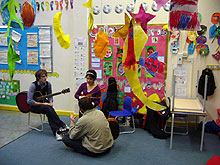
Quick meeting durint the break
During the break, the three leaders remained in the classroom to discuss how to form a structure from what had been made, how they should join in with their instruments, how to create a harmony, and how to link the different parts. After the break, when they were about to review the song together, the children insisted that they wanted to perform the song by themselves, and wanted the leaders to see them perform it. They were beginning to think of the song as THEIR song, and their autonomy grew.
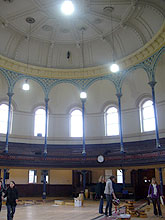
Concert venue: the Round Chapel
Following the seven sessions in schools, they had a rehearsal day. Five groups each in the morning or in the afternoon assembled in a community hall, and performed their music in front of other groups for the first time. Before the arrival of the children, the leaders shared information about the music of their groups, and discussed the whole structure and how the other musicians could join in the performance. Once the children had arrived, Detta and Natasha warmed up their bodies and voices. At first, the children were nervous about meeting other school groups but, through concentrating on the voice and physical exercises, they gradually gained confidence about standing among others.
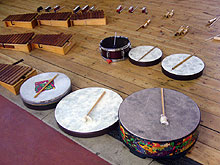
Preparing the musical instruments
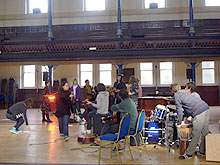
Last meeting with the musicians
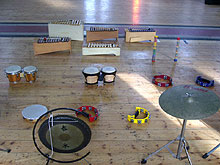
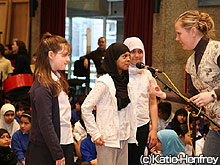
Concert (2008)
Shapla School was the first to perform their song. Thanks to the practice with their teachers and the choreography, they could sing the song that had many 'tastes' with confidence. When they had finished, other groups applauded loudly. Detta asked the other groups some questions: 'What sense of the five senses did Shapla School sing about?' The children replied with confidence, 'Taste!' Detta continued, 'Do you remember what kind of tastes there were?' Then, many children replied, 'salty pizza', 'chocolate', 'gingerbread', and so on. Everyone was curious about the music that the other schools had created, and listened to it very carefully.
Every school group performed their own music one by one. The group with the theme of 'hear' performed a song including whispering: 'Listen to the sounds around you; what they are telling you?' Another group with the theme of 'smell' performed music about the Great Fire of London in 1666, expressing the smell of smoke and burning through the song, body percussion, movement and various musical instruments. However, two out of the ten school groups shared the same 'sense', and none of their music was similar but quite original.
On the day of the concert, the musicians and the children gathered in a multipurpose hall called the Round Chapel, attached to a community church. There were about 300 school-children, teachers and musicians on the floor, and about 50 family members and friends in the gallery.
The concert included not only the performance of each school group, but also the performance by all of the participants at the beginning and the end. It began with a song about total darkness, where there are no senses, and then each of the five senses was awakened by the performance of the children, one by one, and at last there was a song by everyone, in which they explored the world with five senses, which also had an influence on their inner selves. This big piece was named 'Inside Out/ Outside In'. The children had learnt the music at school, but never sung it with all of the other children. In addition, as there were ten groups, they tried to harmonize and sing with the canon, adding extra dynamics to the music. The children and the teachers seemed surprised that they were actually producing such a huge effect, and enjoyed the performance themselves.
Report: Chigusa Futako








